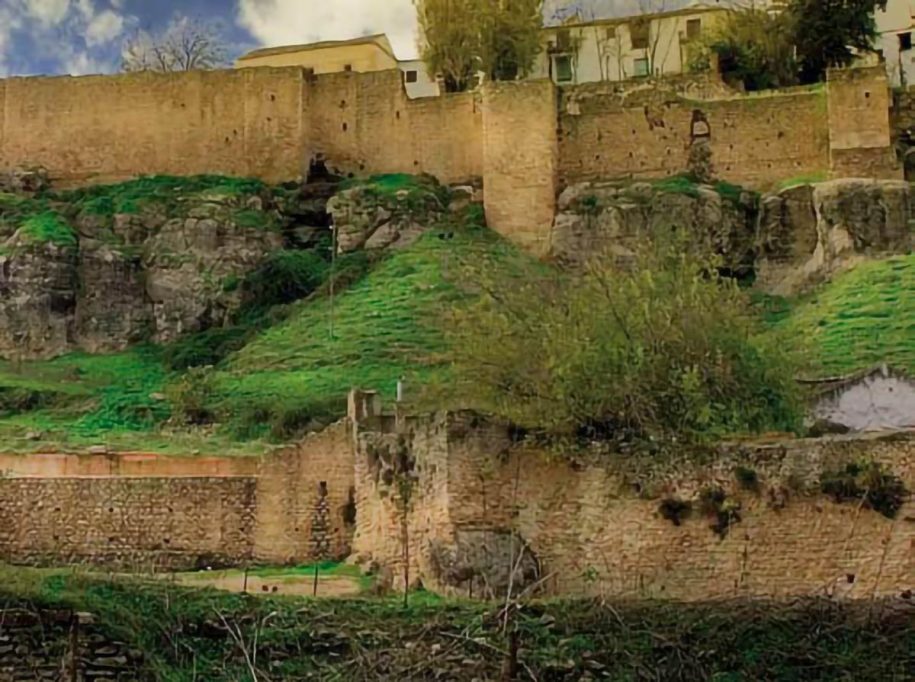It is in the Muslim era when Ronda really strengthens its defensive system, where around its castle an important city is consolidated, which due to its situation, would reach a great military and strategic importance that it will never lose, as a link between Gibraltar and Africa. Its role as an intermediary controlling the relations of eastern Andalusia with the Straits and the lower Guadalquivir is clear from this moment on. Its settlement responds, therefore, to defensive reasons.
The defense of Ronda was made up of a natural element such as the cliff of the Tagus itself, which by itself was enough to defend the city on the north slope and part of the west, acting as a moat that reaches 100 m deep for its steepest part. To the west it was reinforced by a piece of wall that guarded the mills and fulling mills located at the bottom of the river and the albacara, a place destined to shelter livestock in case of danger. This western belt formed rents and was joined to the precipice on the right, while on the left it faced a steep cliff that joined it to the main enclosure. It had two doors, the Puerta del Viento with a segmental brick arch, where you go up a slope to Campillo, and the Puerta de los Molinos, later called Arco del Cristo, through a niche that was made later where a image of Christ; This one was located lower, of limestone masonry, formed by three arches located on the same axis. The two exterior arches are made of brick, horseshoe and framed, framed by an alfiz.
To the south, the walled enclosure became even stronger as it was the most defenseless part and the easiest access. Here, precisely the Castle that occupied the highest part of the city was installed. And under the castle, within the walled enclosure, was the Barrio Alto, today called Barrio del Espíritu Santo, where the main and most monumental door was located: the Puerta de Almocábar, because it is close to the Muslim cemetery (also called Puerta de Ximena , San Francisco, Alameda or Los Caños). Its construction dates from the end of the 13th century, the beginning of the 14th. It has two circular towers on both sides, typical of this type of door, with a triple entrance arch. In Nasrid times it had a rake, a large iron fence located in the slot behind the arch, embedded, which was dropped to intercept the gap, in case of attack, and protect the entrance. In the 16th century, already in the Christian era, by Carlos V, a Renaissance-style door was added, which after the 1965 restoration was moved to the left of the Arab one. On the towers, forming crosses, you can see round stones embedded in the wall, which are some of those used by the Castilian artillery to conquer Ronda.
This large gate gave way to the Barrio del Espíritu Santo, from where the old Calle de las Imágenes started, passing under a large tower and leading to the gate of the same name, which was the only entrance on this side of the Muslim medina, which had a drawbridge and a portcullis.
To the east and northwest, the steep slope and the stream of the Culebras stream served as a moat. In this area there is a triple wall. There are still important remains of the first, and they protected the Alto (Espiritu Santo) and Bajo (or the Tanneries or San Miguel) neighborhoods. The second was the one that surrounded the city and rises at the top of the rocky slope, whose walls and turrets are embedded in the houses and some turned arches are observed to bridge the cracks in the rock. And finally, the fortified houses, which formed like a third wall.
On the eastern side, the entrance to the medina was through the Puerta de la Puente (now disappeared), so called because it is next to the Tanneries or Arab Bridge.
In 1742, in Christian times, the Puerta de Felipe V was erected, it seems to be in the same place that another one from the Muslim era occupied, which on one side has a stone seat, as a resting place on the steep slope, that the town He baptized it as the Armchair of the Moorish King.
Also in this part is the Puerta de la Cíjara or Zixara, which served as communication between the Lower Quarter and the City. There is also, near the Church of the Holy Spirit, within a private enclosure, the Puerta de Espartero or de las Mancebías, which served as communication between the Upper and Lower neighborhoods.
The walls of Ronda, which make our city an authentic impregnable fortress, were restored on numerous occasions throughout history, due to the warlike actions and the influence of the passage of time that deteriorated them.
The defensive system of Ronda was linked in turn with the fortified front that formed a network of fortresses to the west and north of the Nasrid kingdom, some 10 km apart, which started from the Strait of Gibraltar, continued in the area from Cañete, Teba, Campillos, Valle del Genil, to take the west-east direction crossing the region that stretches between Jaén and Granada, until reaching the Segura and de la Sagra mountains.
The fortresses, towers, watchtowers, farmhouses and fortified farmhouses in the western sector of the Kingdom of Granada, formed a dense defensive network, highlighting the fortresses of Malaga, Marbella and Ronda.

